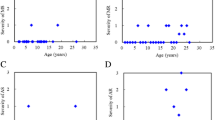Abstract
Mucopolysaccharidosis type I (MPS IS) is a rare autosomal recessive disease caused by a deficiency of the lysosomal enzyme α-L-iduronidase, which is involved in the degradation of sulfated glycosaminoglycans (GAGs). The deficiency results in the intra-and pericellular accumulation of the GAGs heparan sulfate and dermatan sulfate. Eight adult patients with typical features of MPS IS aged 31.5 ± 6.8 years (five men) were included and compared to age-and gender-matched controls. With transthoracic echocardiography, cyclic ascending aortic diameter changes were measured and ascending aortic elastic properties were calculated to characterize aortic elasticity. In MPS IS patients, aortic stiffness index was significantly increased (23.1 ± 10.4 vs 3.9 ± 1.5, P < 0.001), while aortic distensibility was significantly decreased (1.6 ± 0.8 vs 1.6 ± 1.9 Ca2/dynes 10−6, P < 0.001) compared to age-and sex-matched controls. The results of the present study demonstrate that in addition to the known cardiac complications, MPS IS patients have an impairment of ascending aortic elasticity. Further follow-up studies are needed to examine arterial elasticity using other methods in this patient population, and to detect possible effects of enzyme replacement therapy.
Similar content being viewed by others

References
Neufeld E, Muenzer J (2001) The mucopolysaccharidoses. In: Scriver CR, Beaudet AL, Valle D, Sly WS (eds) The metabolic and molecular bases of inherited diseases. McGraw-Hill, New York, pp 3421–3452
Braunlin E, Mackey-Bojack S, Panoskaltsis-Mortari A, Berry JM, McElmurry RT, Riddle M, Sun LY, Clarke LA, Tolar J, Blazar BR (2006) Cardiac functional and histopathologic findings in humans and mice with mucopolysaccharidosis type I: implications for assessment of therapeutic interventions in hurler syndrome. Pediatr Res 59:27–32
Braunlin EA, Berry JM, Whitley CB (2006) Cardiac findings after enzyme replacement therapy for mucopolysaccaridosis type I. Am J Cardiol 98:416–418
Renteria VG, Ferrans VJ, Roberts WC (2006) The heart in the Hurler syndrome: gross, histologic and ultrastructural observations in five necropsy cases. Am J Cardiol 38:487–501
Stefanadis C, Stratos C, Boudoulas H, Kourouklis C, Toutouzas P (1990) Distensibility of the ascending aorta: comparison of invasive and non-invasive techniques in healthy men and in men with coronary artery disease. Eur Heart J 11:990–996
Stefanadis C, Dernellis J, Tsiamis E, Stratos C, Diamantopoulos L, Michaelides A, Toutouzas P (2000) Aortic stiffness as a risk factor for recurrent acute coronary events in patients with ischaemic heart disease. Eur Heart J 21:390–396
Ulusoy RE, Demiralp E, Kirilmaz A, Kilicaslan F, Ozmen N, Kucukarslan N, Kardesoglu E, Tutuncu L, Keskin O, Cebeci BS (2006) Aortic elastic properties in young pregnant women. Heart Vessels 21:38–41
Kasikcioglu HA, Karasulu L, Durgun E, Oflaz H, Kasikcioglu E, Cuhadaroglu C (2005) Aortic elastic properties and left ventricular diastolic dysfunction in patients with obstructive sleep apnea. Heart Vessels 20:239–244
Nemes A, Soliman OII, Geleijnsem ML, Anwar AM, van der Beek NAME, van Doorne PA, Gavaller H, Csajbok E, ten Cate FJ (2007) Increased aortic stiffness in glycogenosis type 2 (Pompe’s disease). Int J Cardiol 120:138–141
Braunlin EA, Hunter DW, Krivit W, Burke BA, Hesslein PS, Porter PT, Whitley CB (1992) Evaluation of coronary artery disease in the Hurler syndrome by angiography. Am J Cardiol 69:1487–1489
Taylor DB, Blaser SI, Burrows PE, Stringer DA, Clarke JT, Thorner P (1991) Arteriopathy and coarctation of the abdominal aorta in children with mucopolysaccharidosis: imaging findings. Am J Roentgenol 157:819–823
Hinek A, Wilson SE (2000) Impaired elastogenesis in Hurler disease: dermatan sulfate accumulation linked to deficiency in elastin-binding protein and elastic fiber assembly. Am J Pathol 156:925–938
Hinek A, Braun KR, Liu K, Wang Y, Wight TN (2004) Retrovirally mediated overexpression of versican v3 reverses impaired elastogenesis and heightened proliferation exhibited by fibroblasts from Costello syndrome and Hurler disease patients. Am J Pathol 164:119–131
Holbrook KA, Byers PH (1982) Structural abnormalities in the dermal collagen and elastic matrix from the skin of patients with inherited connective tissue disorders. J Invest Dermatol 79Supp 1:7s–16s
Rummelt V, Meyer HJ, Naumann GO (1992) Light and electron microscopy of the cornea in systemic mucopolysaccharidosis type I-S (Scheie’s syndrome). Cornea 11:86–92
Wraith EJ, Hopwood JJ, Fuller M, Meikle PJ, Brooks DA (2005) Laronidase treatment of mucopolysaccharidosis I. BioDrugs 19:1–7
Author information
Authors and Affiliations
Corresponding author
Rights and permissions
About this article
Cite this article
Nemes, A., Timmermans, R.G.M., Wilson, J.H.P. et al. The mild form of mucopolysaccharidosis type I (Scheie syndrome) is associated with increased ascending aortic stiffness. Heart Vessels 23, 108–111 (2008). https://doi.org/10.1007/s00380-007-1013-x
Received:
Accepted:
Published:
Issue Date:
DOI: https://doi.org/10.1007/s00380-007-1013-x



